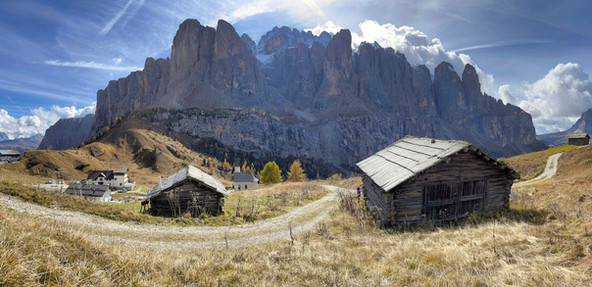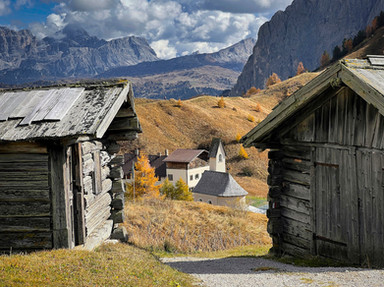More From the Dolomites Photography Workshop
- dougsmith51
- Dec 3, 2022
- 4 min read
We'd previously dropped a blog post about our week in the Dolomites, providing an overview of our time there and the photo workshop we attended. We took almost 2,000 pictures during that single week, so wanted to return with a more detailed view of this beautiful area and our photo explorations. NOTE: This post is longer than normal because it has a lot of photos in it.
Although we were home-based in just two hotels, we spent much of each day on the road, seeing many of the most outstanding features from multiple viewpoints. Our workshop leader, James Rushforth ("Rushy" for short) shared the following map with colored pins representing each day's photo stops.

Sassalungo
One feature that turned up again and again was the mountain grouping called Sassalungo. We first saw it as we crossed a pass on our first day and over the next couple of days viewed it from different angles and at different times of day.





Punta Santner
This mountain with its end spike could be seen from our hotel balcony and also provided backdrops to other scenes.




Sass Rigais
A picture of the Sass Rigais wall caught our attention and started us on this whole trip to Italy. We arrived on a cloudy but beautiful day and climbed uphill for more and more expansive views.





Sella Ronda
We spent an entire day on a trip around the Sella Group mountains (thus, Sella Ronda), going through four passes before returning to our starting point.





All over the Dolomites are small huts that add greatly to photo settings with their weathered appearance.

At the last of the four passes, we took a gondala up to the Sass Pordoi viewpoint. A group of paragliders were also up there, although only one was able to take off and glide down to a distant valley.




Chiusa (Street Photography)
Not all our photography was of dramatic landscapes. One day we wandered the old medieval portion of the town of Chiusa, finding interesting scenes, small items, and doorways.





Cinque Torri
Late one afternoon we hiked to the "Five Towers."



Although the Cinque Torri rise above you as you hike up, you can see in the photo below (taken from a gondola landing) that it's a rock outcropping sitting on a ridge and is below the level of the surrounding mountains.

Lakes
We visited several lakes during our time in the Dolomites. One of the most dramatic (and a huge tourist attraction) was Lago di Braise with its green water and wooden rowboats.



As the sun was setting that same day, we stopped by Lago di Dobbiaco.


One morning we rose at dawn to capture photos at Lago Antorno. Not only were there great lake reflections, the sky was a magical pink at dawn. At the other end of the lake, we could see the mountains screening the Tre Cimi which we would visit another day.




On our next-to-last day, we visited Lago Ghedina, a small lake with pretty reflections and interesting banks.


Tre Cimi
The hike up to the "Three Chimneys" was the most strenuous of the trip. It was 2+ miles each way and about a 600-foot change in vertical elevation. Part of the challenge was that we had to park on the "wrong" side of the cliffs and then walk around to the viewpoint.


However, it was definitely worth the time and effort!





The sun was setting during our return trek, allowing some amazing photo opportunities of the landscape and tiers of rugged peaks off into the distance.




Fall Colors
The fall colors had arrived by the time we reached the Dolomites, although there were still a few wildflowers to be found. The primary fall color is yellow due to the many larches in the area. The larch is a deciduous conifer with needle-like flowers that turn yellow, fall off, and then regrow the next year. There are other deciduous trees like oaks and maples that add colors to the fall mix.
Brunico World War I Graveyard
This graveyard, still lovingly maintained by the local community, contained the graves of combatants of several faiths, most of whom died in the hospital that had been set up in the local castle.







The Dolomites at War
Toward the end of our trip, we took another gondola ride from the Lagazuoi pass to a high mountain viewpoint. We learned that this area had been right on the combatant lines during World War II and that an extensive tunnel system had been built through the mountains to allow soldiers to get to and from their posts. You can still the use the tunnels today, although you need to use cables to get through - part of an extensive system of via ferrata (iron roads) that are part of the hiking and climbing environment of the Dolomites.





Before we returned on the gondola to the pass, Rushy used his drone to shoot a parting photo of the workshop participants.
Photographers at Work
You're used to seeing photographers' photos, but fewer pictures of them at work capturing those photos. Here's some of our group on the hunt for good shots.





A Sampling of Photos from Other Workshop Participants
In terms of photo skill and dedication, we were probably at the middle level of the group. Although all were amateurs (except for the two workshop leaders), some were serious amateur photographers with serious equipment. There was a photo sharing site for use in the group, and we wanted to highlight the work (anonymously) from some other participants in the workshop (not everyone chose to share).
Photographer 1




Photographer 2




Photographer 3




Photographer 4




Photographer 5













































Wow! just Wow! The scenery, of course, speaks for itself, but the framing of the photographs is fabulous. The hallmark of good photos is how they are able to draw the viewer into a scene, and yours certainly hit the mark!
(And, having spent time in the Swiss Alps this summer I can "jump" into anyone of those scenes. As always, thanks for sharing!)